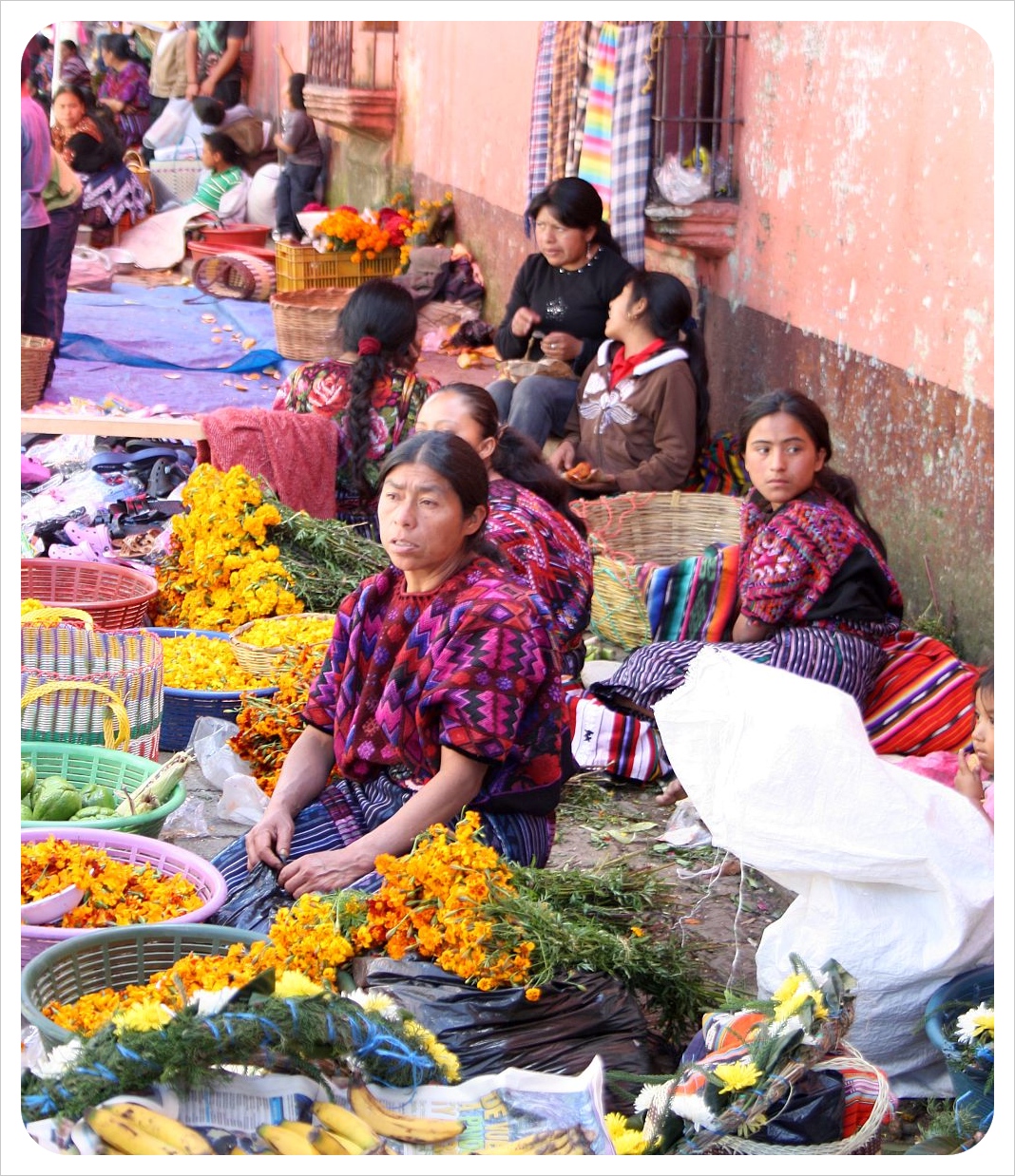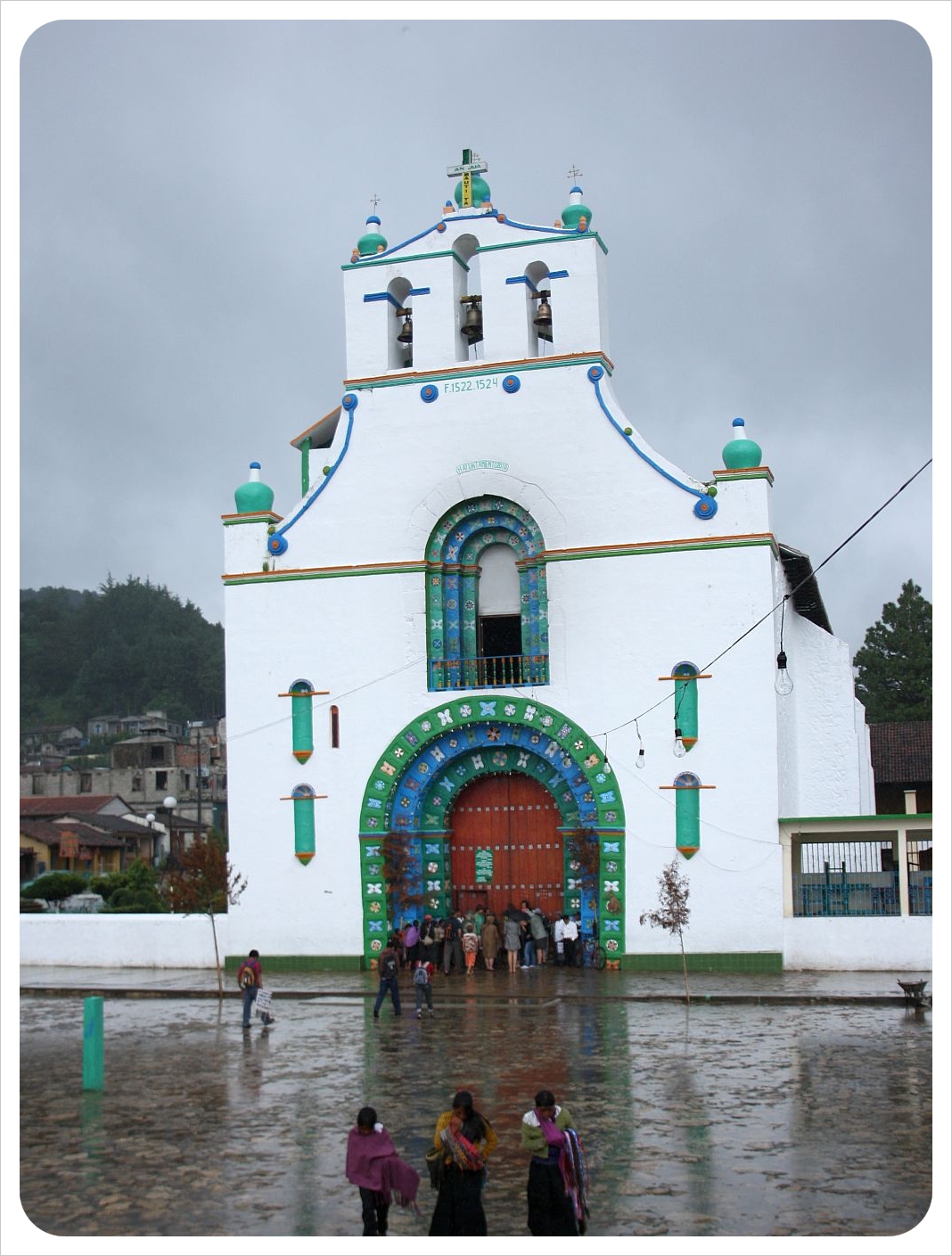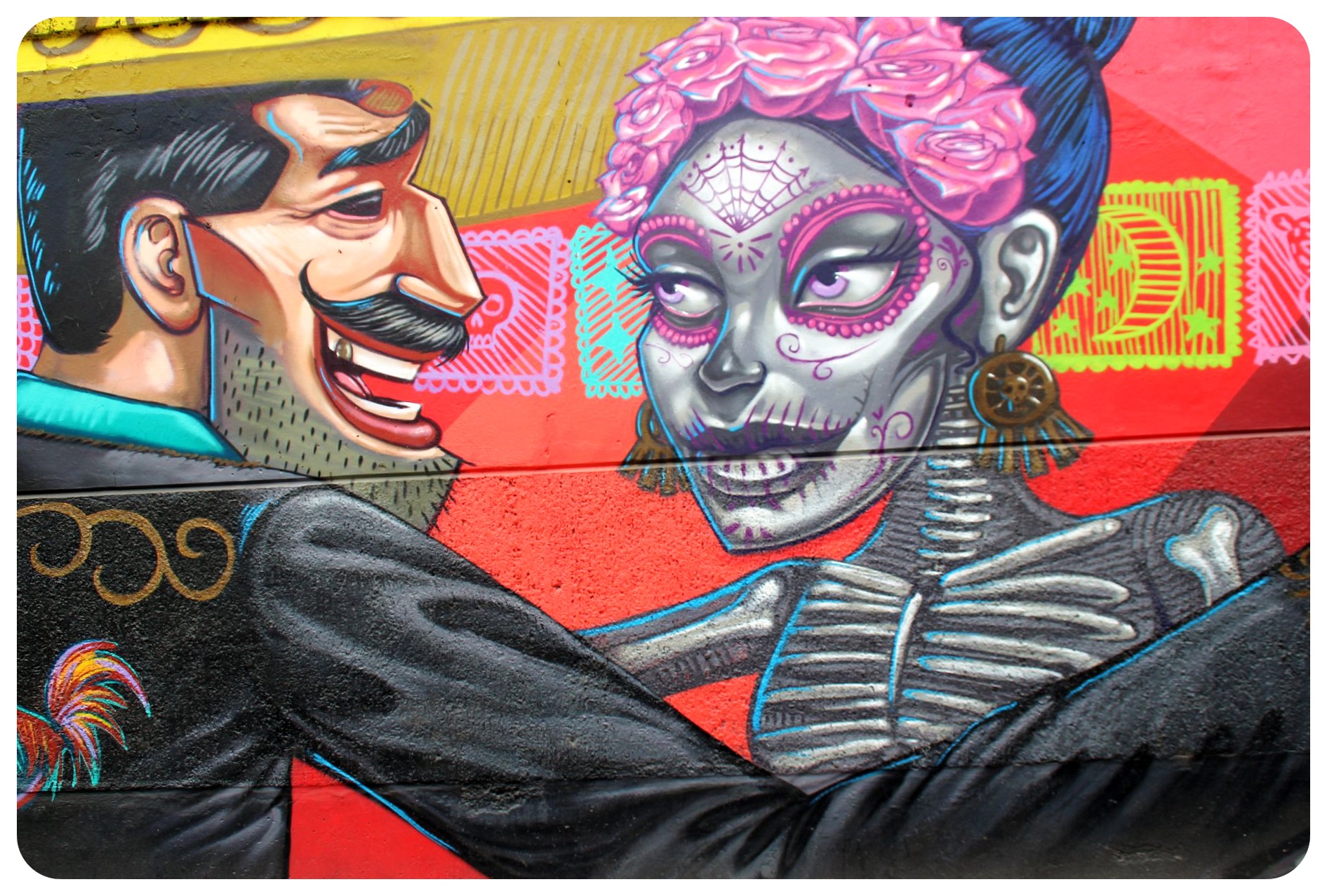Last Updated on February 3, 2024
Two shiny new Ford transporter vans stop along the side of a white cement road and nearly 30 passengers pile out and reformulate into the small groups everyone came with. Dani and I stand off to the side and observe with some shock the other tourists in the group. A group of Brazilians (both female and male) in tank-tops, short-shorts and movie-star sunglasses and several girls in short-ish skirts.
Before you start thinking Dani and I to be very prude (standing there in our long pants, closed toe shoes and jackets), we should explain that our tour was taking place in traditional Mayan villages outside of San Cristobal de las Casas, Mexico. The agency we booked our Mayan village tour with had mentioned that we should wear appropriate clothes out of respect to the villagers – advice apparently very few of us chose to heed.
Organized Mayan Village Tours: Tourism or Trespassing?
Organized Mayan Village Tours in Chiapas
The tour is one of the most common tours available in San Cristobal, offered by all major tour operators in town. You visit San Juan Chamula, the largest Tzotzil Maya community in Mexico’s southern state of Chiapas, and the nearby Tzotzil village Zinacantan. In addition to the (apparently optional) modest clothing request, the agency had also made clear that photographs of the Mayans were strictly prohibited without their permission.
We strolled through the village at 8.30am, trying to soak up what life must be like in these Mayan villages. Others seemed to have less interest. A well-off Mexican family seemed utterly bored, and the father was attached to his cell phone – rudely working through the entire tour. Several very loud conversations were taking place in Spanish, English German, Portuguese and Dutch and few were engaging in any way with the tour.
Our discomfort with our disrespectful fellow tourists only worsened when it became clear just how much the people of the village, especially the elders, did not really want us there. San Juan Chamula, known locally as Chamula, is essentially a ‘showcase’ village, a designated ‘tourist friendly’ spot with busloads of tourists shuffling through its streets and magnificent church each day, their Canons and Nikons worth a local families’ annual wage dangling carelessly from their necks. We were constantly being Sshhhh-ed away from taking pictures if there was any chance of a family member being photographed.

Following the trail of the ancient Maya
Dani and I were trying to be anything but disrespectful, as we are fascinated with the Maya people and culture, an interest which has grown along the Mayan trail we have been following for some time.
Learning about the Maya, both past and present, has been one of the most interesting aspects of our travels so far. Some of the different groups of Maya people in Mexico, Guatemala, Belize, Honduras and El Salvador today live a very simple, rural life. Others have adapted to city life while maintaining their culture and language.
One method of survival for the hundreds of Mayan groups throughout what this large area known formerly as Mesoamerica is to manufacture and sell their traditional, brightly-colored woven goods to tourists – hand-made blankets, bracelets, shirts and pants, as well as new adaptations such as water bottle holders, wallets, and placemats.

This is often the only side of Mayan life we as visitors have the chance to see, and the conversation with Mayans in places like San Cristobal in Mexico or Antigua and Chichicastenango in Guatemala can easily be limited to the attempted sale and purchase of these goods. This is why we were so eager to take part in the tour in San Cristobal, to learn more and see the indigenous Maya in their ‘authentic’ home environment.
Despite the feeling that we were intruding on the village, we had an excellent guide, Alejandro, who was able to provide a strong introduction into the culture and traditions of the Tzotzil Maya. He especially covered the blending of Mayan and Spanish religions including the background of the Mayan cross and the adoption of Jesus as the main religious figure. He did this in Spanish, then in English, all while shouting out ‘Hellos’ and ‘Good Days’ to the villagers in their native language. A tall, handsome academic, Alejandro obviously commanded a level of respect in the village, the girls followed and giggled with him, the men shook his hands and he made everyone feel at ease.
The highlight of the tour for Dani and I was the trip into the church. A bouncer of sorts at a small wooden door in the front of the church was enforcing a one group in, one group out policy to keep numbers inside low, so we waited for a group of French tourists to exit with their guide before our group of 28 half-naked camera-toting Europeans were allowed inside.

Once inside, we tried to put the discomfort behind us and take in our surroundings. Pine needles were strewn about, completely covering the floor, and walking on them was more like hiking than any organized religious experience. A thick fog of incense smoke filled our noses as we carefully moved around spots where pine needles had been cleared to make way for dozens, even hundreds of thin white candles. Instead of rows of wooden benches, Mayan families sat cross-legged on the floor in front of these patches of candles, chanting, kneeling and praying.
The sky outside dark gray and inside some of the windows were closed or covered, so that the church was dark inside, lit primarily by these hundreds of dancing flames on the floor. All the while, several tour guides struggled in raised whispers to explain the scene to the groups of tourists. It was difficult to reconcile the conflicting feelings of taking part of a private, religious Mayan experience and yet being terribly disrespectful intruders.
At the home of Tzotzil Mayas
Later, in Zinacantan, Alejandro took us to the home of Dona Antonia and her family, a ‘showcase house’, for a (manufactured) glimpse of daily Mayan family life: they demonstrate weaving, we watched the girls make tortillas, tasted a fresh tortilla filled with home-made cheese and beans, and peeked into a typical Maya house and bedroom. Then the typical bargaining began, as people bought several handicrafts items.
Here we felt more comfortable as Dona Antonia really welcomed visitors into the home, pictures were encouraged and the concept of tourism was understood and welcomed. It was clear that this particular family was reaping the benefits of the tour groups. However, despite being friendly and welcome, it was hard not wonder how much they really like being snapped by hundreds of cameras on a daily basis and having noisy foreigners traipsing through the property seven days a week?

Another way of experiencing Maya culture
While in Mexico, the Maya experience was distanced and pre-packaged, but in Guatemala intermingling with the indigenous Maya groups is part of the everyday experience. Suddenly you are surrounded by hundreds of indigenous women, men and children, central parks and city streets bursting with the colors of their traditional clothes.
Mayan villages are everywhere, and in areas well on the beaten path, around Lake Atitlan and Chichicastenango for example, visitors are welcome any time. Contrary to the Mayans in Mexico, the Mayans in Guatemala seem much more accessible. That church in Chamula, Mexico was the only Mayan church we saw during our 12 weeks in Mexico, and yet in Guatemala we have passed through countless entrances and walked upon pine needles and around the candles on the floor, free of bouncers and tour groups.
 As long as they are asked, Guatemala’s indigenous are much more open to having their picture taken, especially if you slip one or two quetzales ($0.10-0.15) in their hands after. Does this mean that the Mayans in Guatemala, with their tourist-friendly markets and openness to photography, are just more open to selling their culture for a profit?Not quite. Profiting from tourism can hardly be looked down upon in Central America where tourism is a major part of what fuels the national economy. A visit to Todos Santos Cuchumatan, a Maya village in the far northern part of Guatemala’s Western Highlands will quickly reassure you that the Mayan way of life is still in full swing far, far away from the tourist trail.
As long as they are asked, Guatemala’s indigenous are much more open to having their picture taken, especially if you slip one or two quetzales ($0.10-0.15) in their hands after. Does this mean that the Mayans in Guatemala, with their tourist-friendly markets and openness to photography, are just more open to selling their culture for a profit?Not quite. Profiting from tourism can hardly be looked down upon in Central America where tourism is a major part of what fuels the national economy. A visit to Todos Santos Cuchumatan, a Maya village in the far northern part of Guatemala’s Western Highlands will quickly reassure you that the Mayan way of life is still in full swing far, far away from the tourist trail.
Because there are almost no tourists (save for the famous Day of the Dead horse race on 1 November) we were not surrounded by street vendors asking us to buy (“A table cloth for your mother, come, buy it!”). Instead, the two of us were examined with the same curiosity and interest that we had for them. We had chats with people, felt comfortable just sitting in the park and watching life go by. Walking through nearby villages, just the two of us, brought us to women weaving on their front porches and men harvesting corn.
These were not showcase villages, and the moments of everyday life captured in our minds and on camera were as authentic as they come. The villagers didn’t expect us, but greeted us with a smile. If they didn’t want us to take their picture, they politely refused, rather than that embarrassing ‘Sshhing’ we were met with in the supposedly ‘tourist friendly’ village in Mexico.
 To take the tour or not take an organized Maya village tour, that is the question. During our time in Todos Santos, we felt authentically immersed and very comfortable, but we realized at that time just how much we learned about the Mayans during our tour with Alejandro. Do we recommend taking an organized tour of Mayan villages? Would we do the tour again if we could do it all over again?
To take the tour or not take an organized Maya village tour, that is the question. During our time in Todos Santos, we felt authentically immersed and very comfortable, but we realized at that time just how much we learned about the Mayans during our tour with Alejandro. Do we recommend taking an organized tour of Mayan villages? Would we do the tour again if we could do it all over again?
Now that we have been in Guatemala, we would not do the tours in Chiapas. In Guatemala, the Maya communities are much more accessible and open, and you can visit with feeling like you are trespassing on private property. While we did learn a lot from Alejandro on our tour, we would recommend looking for more authentic ways to learn about Mayan culture. The Mayans in Guatemala are very proud of their culture and happy to talk to visitors.
For some real fun, have a chat with the child vendors. Though they may not have their facts straight (someone told us about how Hernan Cortes was only recently in Guatemala), these kids are happy to tell you about their culture and their daily lives, innocently and honestly giving you a better glimpse into Mayan life than some tour guides do.

Other ways to learn about the Maya culture:
- Go off the beaten path and visit predominantly Mayan villages/towns like Todos Santos in Guatemala.
- Take Spanish classes and find a teacher with knowledge of the Mayan community to ask questions and learn. Teachers are always relieved to get off topic, especially when they can justify the conversation as a learning experience. Around Lake Atitlan in Guatemala, many of the teachers are Mayans themselves and can give you a great education on their culture.
- Homestay – Stay with a Mayan family. Even if you do not wish to sign up for Spanish classes, many schools will book you a homestay with a Mayan family for a very reasonable price (less than $100.00 per week for accommodation including three meals).
- Engage. It’s difficult to get many of the Mayan in the tourist centers to have a real conversation with you as selling tends to be their primary objective. But if and when possible, ask and try to learn from them where you can.

Have you done a Maya village tour? How do you feel in these situations? Have you had more ‘authentic’ experiences with Mayans in Mexico? Would you recommend any tours or how about alternatives to a more ‘authentic’ experience? We would love to hear it in the comments below.






Anni
Friday 20th of April 2012
I would agree that most of the standard village tours offer a very uncomfortable and voyeuristic experience, leaving the tourists completely devoid of anything authentic. Luckily some great alternatives have begun to pop up for those of us that do want to scratch beneath the surface.
I'm not aware of any organisations doing sustainable tours in Chiapas but in Oaxaca there is a wonderful local NGO called Fundación En Vía http://www.envia.org/ which organises microfinance tours to Zapotec villages in the Oaxaca valley. Out of these, especially Teotitlán del Valle has traditionally been the number one destination for tours from the city of Oaxaca, with tourists arriving to buy the beautiful tapetes or rugs made in the town. The vast majority of these tours fail to provide the tourists anything more than with a “showcase” shopping trip.
What makes En Vía different is that the tours are actually designed to be a cultural exchange between locals and travellers. The 50 USD tour fee goes directly to the local participants in the form of interest-free microloans, and the tourists get an authentic, welcoming experience. Whilst being more expensive than your average tour, knowing that the money goes to benefit the local community and provides an enjoyable experience for both the locals and the travellers makes it definitely worthwhile. I cannot recommend them enough.
Ekua
Monday 26th of September 2011
I had a similar experience where I felt like I was partaking in a human zoo experiment when I visited a long neck tribe in northern Thailand. It felt so wrong.
But I went San Juan Chamula (which I'll probably write about next) and had a different experience. I think it's because I happened to go on a day where there was a huge festival going on. And my tour wasn't as much of a tour as it was a group of people who went together from the hostel. We were totally outnumbered by the locals in the main square, few people dared to take photographs and the people participating in the festival went about their business like we were not there.
I haven't yet been to Guatemala, but after visiting Chiapas, I'm even more intrigued by it. Sounds like it's a lot more indigenous overall whereas in Chiapas, the Mayan community often seems ignored or put in these "showcase" boxes.
jess
Tuesday 27th of September 2011
Hey Ekua - interesting how different your Chamula experience was, but I think that had a lot to do with the huge festival going on, for sure. Guatemala is so much more indigenous, and one major difference is that while the Mexican Mayans are separated and 'showcased', the Guatemala Mayans are a part of everyday life and culture. You'll ride the buses, shop at the same stores, buy the same things, have both banal and exceptionally interesting conversations with them every day. Can't wait to hear what you think!
Rebecca
Sunday 19th of December 2010
Totally agree with you ladies. I did a similar tour to Chamula and felt like everyone I was with was wandering along the road, talking amongst themselves instead of listening to our guide tell us about the fascinating history of the town and the people. And then one guy looked surprised when a mother (hanging washing in her front yard with her children at her feet) started throwing rocks at him while he was taking a photo of her!! Despite the fact that we'd been told time and time not to take photos, period. Grrrrr.
jess
Tuesday 21st of December 2010
@Rebecca So it's like that pretty much every single day and that makes it even worse! In Guatemala you can just visit Mayan villages minus the tours, and it's just so much more real. Plus the locals look back at you with curiosity, not disgust. Glad you agree that travelling is about exploration and discovery, not pissing off the locals. After all, that's what Cancun is for! Thanks for stopping by!
Claire
Saturday 4th of December 2010
I agree with Ayngelina above. I feel that the very presence of hordes of tourists traipsing their villages/homes/farms, cancels out any shred of authenticity, so I try to avoid them altogether. And it really burns me up when others don't have respect for the local culture and dress as the people you described in your post.
jess
Tuesday 7th of December 2010
@Claire Exactly right. We tried it once, but I can't see us doing another one of these tours again. Not just because of the traipsing and trespassing, but also that level of disrespect of the other tourists. Made us feel really terrible, just like you say.
Ayngelina
Saturday 4th of December 2010
I did a similar tour in Chamula and was very uncomfortable, there's something about treating people like tourist attractions that just makes me feel icky.
I also went inside the church where there were several women praying and quite emotional about it. I'd say it was one of the times where I felt like I really shouldn't be somewhere.
jess
Tuesday 7th of December 2010
@Ayngelina Some of the men and women were crying, on their knees, and there's this guy with daisy dukes on in our group shuffling through the pine needles in his flip-flops. Terrible. We learned right there that what's really important is to really get to know people and their towns. If we can't learn about them authentically and spend time with people who actually want us around, we'd rather leave it completely.